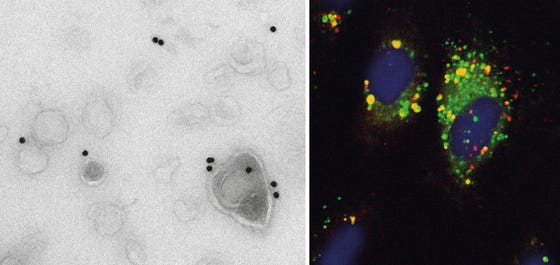Extracellular vesicles for drug delivery
Extracellular vesicles (EVs) are nanoparticles, 30-1000 nm in size, with an aqueous core and phospholipid membranes. They are produced by cells particularly when cells are activated. Historically, they have been implicated in 'cell waste management' and activation of coagulation. More recently, the discovery that they contain selected RNAs and proteins that can be transferred from one cell to another suggests a new form of long distance intercellular communication.
Our lab studies EVs as potential drug carriers. We develop methods for large scale EV isolation, investigate tools for drug loading and design novel ways to achieve cell targeting. In addition, we aim to characterize EV components important for uptake and processing by target cells, in order to improve synthetic drug delivery systems through EV-inspired engineering.

Research team uitklapper, klik om te openen

Dr Pieter Vader, Principal Investigator
(Profiles: PURE, Researchgate, Loop)
Team:
- Olivier de Jong
- Sander Kooijmans
- Susan van Dommelen
- Linglei Jiang
- Jerney Gitz-Francois
- Sandra Drost-Verhoef
Research opportunities uitklapper, klik om te openen
We welcome students for research periods in our lab. Usually we have around 3 positions for national and international students. If you are interested in extracellular vesicles and/or nanomedicine, please contact Pieter Vader to see if we have positions available.
Key publications uitklapper, klik om te openen
Key publications of our group (Full list here)
- Vader P, et al. Extracellular vesicles for drug delivery. Advanced Drug Delivery Reviews.
- Willms E, et al. Cells release subpopulations of exosomes with distinct molecular and biological properties.
Scientific Reports.Sci Rep 6:22519 (2016). - Kooijmans SA, et al. PEGylated and targeted extracellular vesicles display enhanced cell specificity and circulation time.
Journal of Controlled Release 224: 77-85 (2016). - Nordin JZ, et al. Ultrafiltration with size-exclusion liquid chromatography for high yield isolation of extracellular vesicles preserving intact biophysical and functional properties.
Nanomedicine: Nanotechnology, Biology and Medicine 11(4): 879-883 (2015). - Kooijmans SA, et al. Electroporation-induced siRNA precipitation obscures the efficiency of siRNA loading into extracellular vesicles.
Journal of Controlled Release 172(1): 229-238 (2013).
